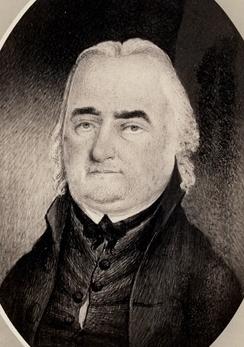President: 1793-1796, 1806-1808
Fr. Robert Molyneux, S.J., served as Georgetown's second and fifth president from 1793-1796 and 1806-1808. Fr. Molyneux oversaw the beginning of construction on Old North during his first presidency.
Early Jesuit career
Fr. Robert Molyneux joined the Society of Jesus in 1757, and he pursued the of typical education of an English Jesuit at that time studying at St. Omers, Bruges, and Liége. In 1771, he was sent to America where he served as a pastor at St. Mary’s church in Philadelphia through the American Revolution.1There, Fr. Molyneux created the first parochial school in the United States in 1782.2
In 1786, Fr. Molyneux was appointed one of the directors of Georgetown, and he helped draft the school's curriculum. Bishop John Carroll was eager for Fr. Molyneux to serve as Georgetown’s first president, but Fr. Molyneux declined the position. In February 1788, Fr. Molyneux left Philadelphia for Maryland where he served as a pastor at Bohemia Manor. In 1793, after Fr. Plunkett announced his desire to retire, Bishop Carroll again offered Fr. Molyneux the position of president. This time he accepted, and on June 14, 1793, Fr. Molyneux became Georgetown’s second president.3
First presidency
During Fr. Molyneux’s three year tenure, enrollment increased from seventy-six to nearly a hundred students. While a new building was authorized during Fr. Plunkett’s presidency, Fr. Molyneux oversaw the purchase of a few acres on the north side of Old South, and the construction of what would become Old North began in 1794. The new four-story brick building, modeled after Nassau Hall at Princeton, quintupled dormitory space, added additional classrooms, and housed a chapel.4
First retirement
Fr. Molyneux retired on October 1, 1796, before Old North formally opened. Regarding Fr. Molyneux’s retirement, Bishop Carroll wrote, he “found the employment of President of this institution too bustling, and requiring too much energy for his good-natured and somewhat torpid disposition, and after many entreaties he has obtained a release from it.”5
In 1801, after Pope Pius VII permitted the Society of Jesus to exist in Russia, Bishop Carroll convened all the former Jesuits at St. Thomas Manor in Maryland. There they elected to run the risk of rejoining the Society via the Russian province. Fr. Molyneux was appointed superior of the Jesuits' Maryland Mission in 1805.6
Second presidency
On October 1, 1806, Fr. Molyneux again assumed the position of president of Georgetown. During his second tenure, he established a Jesuit novitiate and a scholasticate at Georgetown. Fr. Molyneux also continued to oversee the completion of Old North. With limited funds available, only the third floor had been prepared for formal use, and the windows of other floors remained unglazed and boarded up. After an anonymous postulant donated $400, a plasterer was procured, and the Jesuits themselves prepared the necessary mortar. The windows were glazed, and the Jesuits painted the building’s interior.7
Resignation and death
A year into his second presidency, Fr. Molyneux began to suffer from worsening dropsy and asthma. In 1808, he appointed Fr. Francis Neale to fill both the role of superior of the Maryland Jesuits and interim president of Georgetown. On December 8, 1808, Fr. Molyneux died and was laid to rest in Georgetown’s Jesuit Community Cemetery.8
- 1Daley, John. “Georgetown University: Origin and Early Years.” 1957, p.78.
- 2Joyce, Daniel R.J. "A Jesuit's Perspective: Education Links Pope Francis, Philadelphia and SJU." Saint Joseph's University Magazine. 2015, pp. 16–17.
- 3“Father Robert Molyneux.” Woodstock Letters, Vol. LVIII, No. 1, 1938, pp.271-92.
- 4Emmett Curran, Robert. “The Bicentennial History of Georgetown University: From Academy to University, 1789–1889.” 1993, pp.45-47.
- 5“Father Robert Molyneux,”p.283.
- 6Gilmary Shea, John. “Memorial of the First Century of Georgetown College, D.C.” 1891, pp.30-34.
- 7Id. at p.34.
- 8“Father Robert Molyneux,” p.290.


